

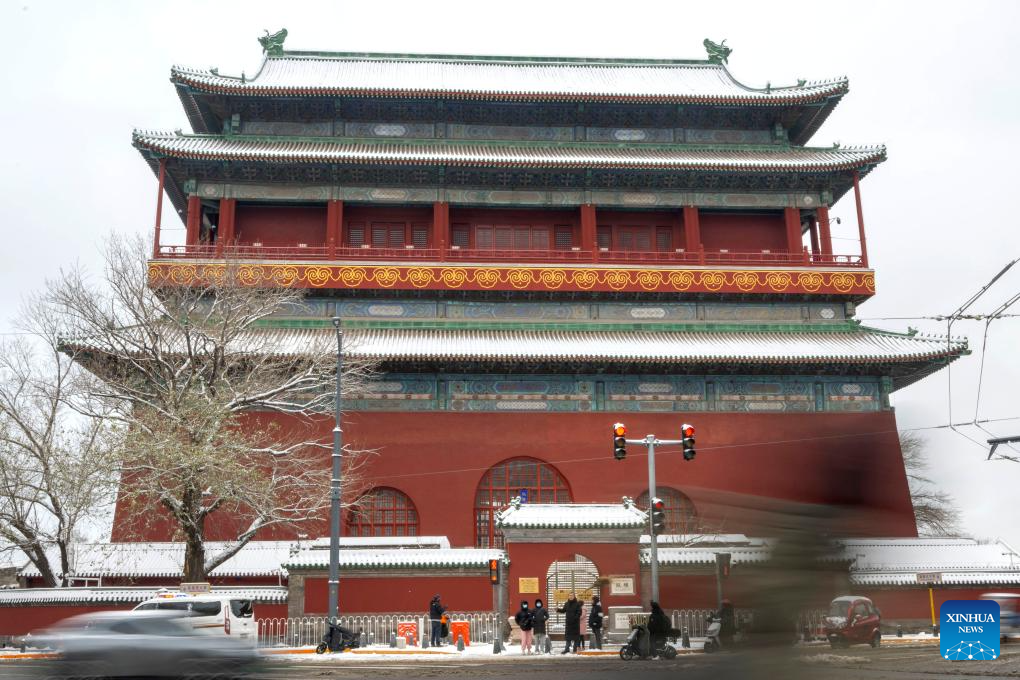
This photo taken on Dec. 11, 2023 shows the snow scenery of the Drum Tower in Beijing, capital of China.
First created in the Yuan Dynasty (1271-1368), the Beijing Central Axis, or Zhongzhouxian, stretches 7.8 kilometers between the Yongding Gate in the south of the city and the Drum Tower and Bell Tower in the north. Most of the major old-city buildings of Beijing sit along this axis.
Gates, palaces, temples, squares and gardens of the old city are all linked up to the axis. As they witnessed the folk activities along the line from old days to new ones, they themselves are a joy to behold at all times. (Xinhua/Cai Yang)
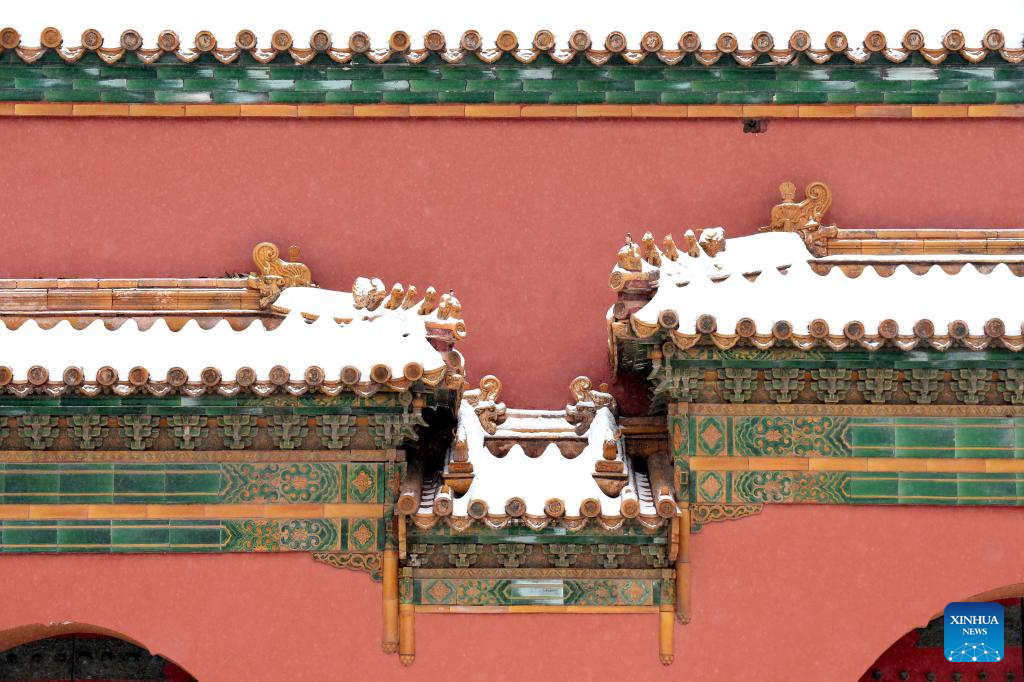
This photo taken on Dec. 14, 2023 shows a corner of the Palace Museum covered by snow in Beijing, capital of China.
First created in the Yuan Dynasty (1271-1368), the Beijing Central Axis, or Zhongzhouxian, stretches 7.8 kilometers between the Yongding Gate in the south of the city and the Drum Tower and Bell Tower in the north. Most of the major old-city buildings of Beijing sit along this axis.
Gates, palaces, temples, squares and gardens of the old city are all linked up to the axis. As they witnessed the folk activities along the line from old days to new ones, they themselves are a joy to behold at all times. (Xinhua/Luo Xiaoguang)
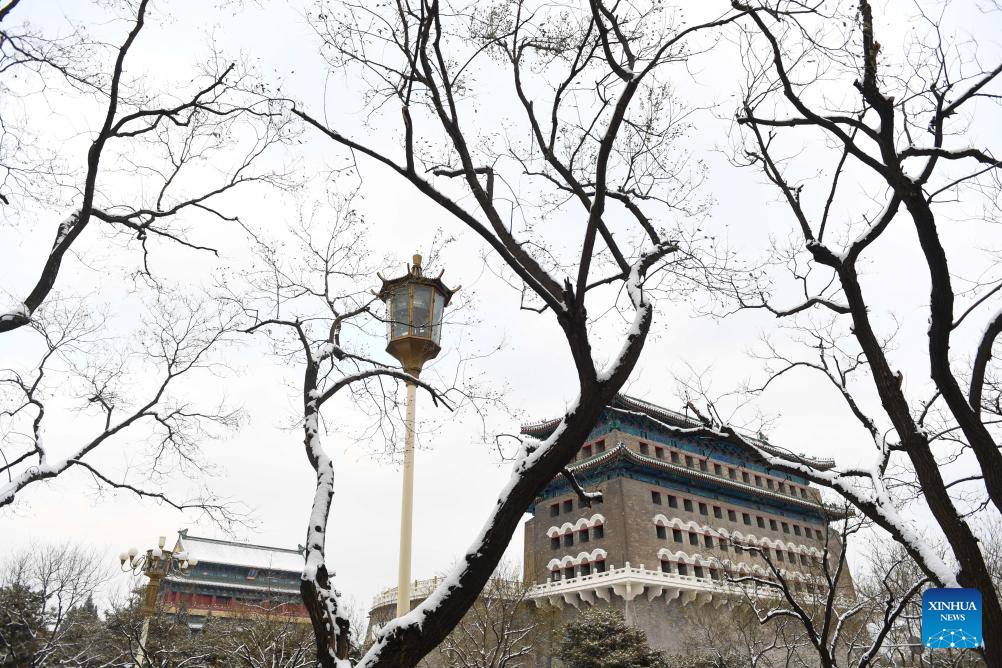
This photo taken on Dec. 11, 2023 shows the Zhengyang Gate (L) and its arrow tower in snowfall in Beijing, capital of China.
First created in the Yuan Dynasty (1271-1368), the Beijing Central Axis, or Zhongzhouxian, stretches 7.8 kilometers between the Yongding Gate in the south of the city and the Drum Tower and Bell Tower in the north. Most of the major old-city buildings of Beijing sit along this axis.
Gates, palaces, temples, squares and gardens of the old city are all linked up to the axis. As they witnessed the folk activities along the line from old days to new ones, they themselves are a joy to behold at all times. (Xinhua/Ju Huanzong)
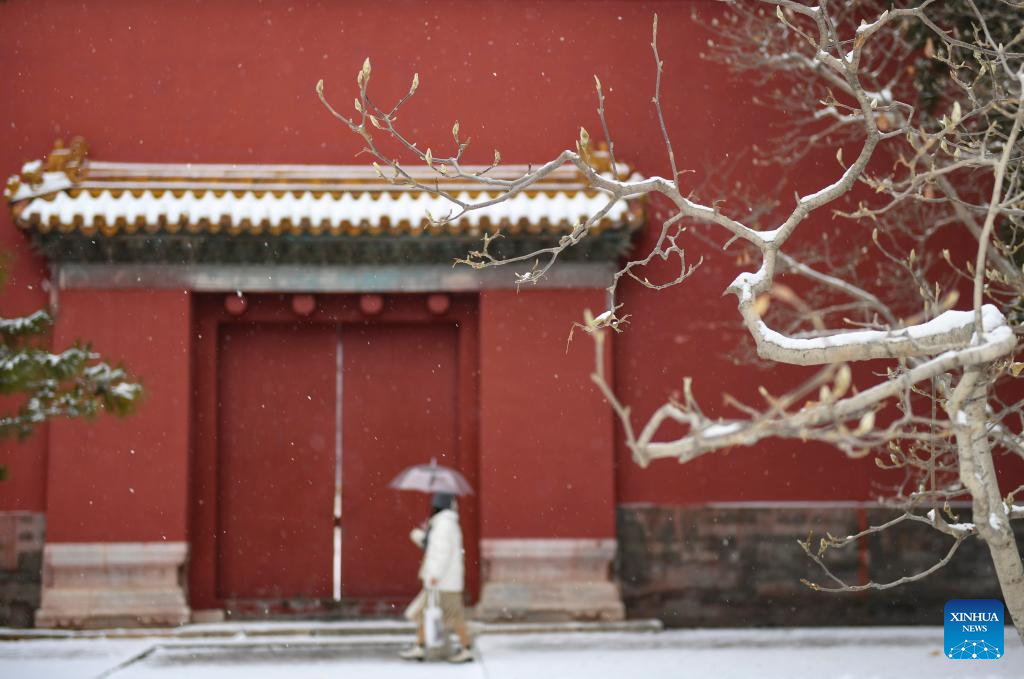
This photo taken on Dec. 14, 2023 shows a gate of the Imperial Ancestral Temple in snowfall in Beijing, capital of China.
First created in the Yuan Dynasty (1271-1368), the Beijing Central Axis, or Zhongzhouxian, stretches 7.8 kilometers between the Yongding Gate in the south of the city and the Drum Tower and Bell Tower in the north. Most of the major old-city buildings of Beijing sit along this axis.
Gates, palaces, temples, squares and gardens of the old city are all linked up to the axis. As they witnessed the folk activities along the line from old days to new ones, they themselves are a joy to behold at all times. (Xinhua/Chen Zhonghao)
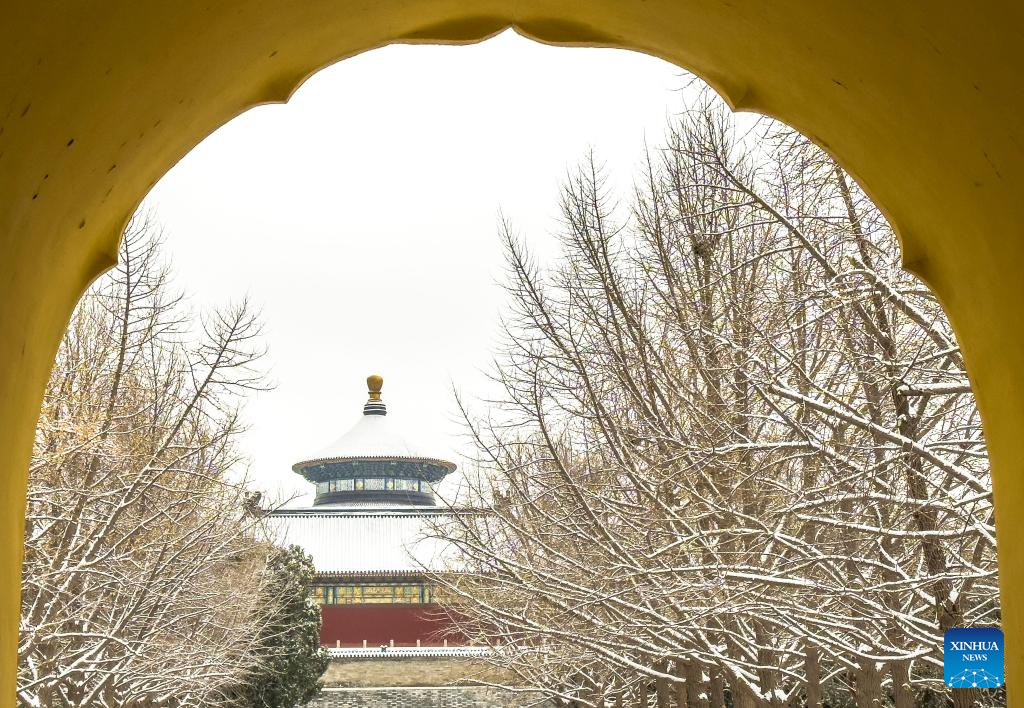
This cellphone photo taken on Dec. 11, 2023 shows the snow scenery of the Hall of Prayer for Good Harvest of the Temple of Heaven in Beijing, capital of China.
First created in the Yuan Dynasty (1271-1368), the Beijing Central Axis, or Zhongzhouxian, stretches 7.8 kilometers between the Yongding Gate in the south of the city and the Drum Tower and Bell Tower in the north. Most of the major old-city buildings of Beijing sit along this axis.
Gates, palaces, temples, squares and gardens of the old city are all linked up to the axis. As they witnessed the folk activities along the line from old days to new ones, they themselves are a joy to behold at all times. (Xinhua/Mu Wenchun)
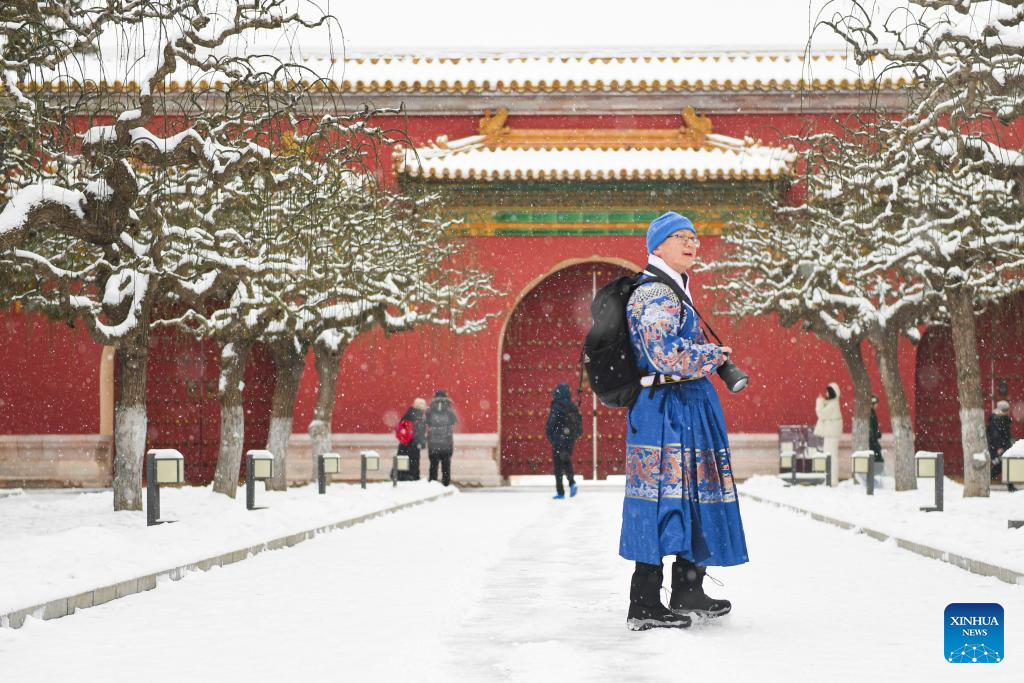
A visitor takes photos of snow scenery in front of the Imperial Ancestral Temple in Beijing, capital of China, Dec. 14, 2023.
First created in the Yuan Dynasty (1271-1368), the Beijing Central Axis, or Zhongzhouxian, stretches 7.8 kilometers between the Yongding Gate in the south of the city and the Drum Tower and Bell Tower in the north. Most of the major old-city buildings of Beijing sit along this axis.
Gates, palaces, temples, squares and gardens of the old city are all linked up to the axis. As they witnessed the folk activities along the line from old days to new ones, they themselves are a joy to behold at all times. (Xinhua/Chen Zhonghao)
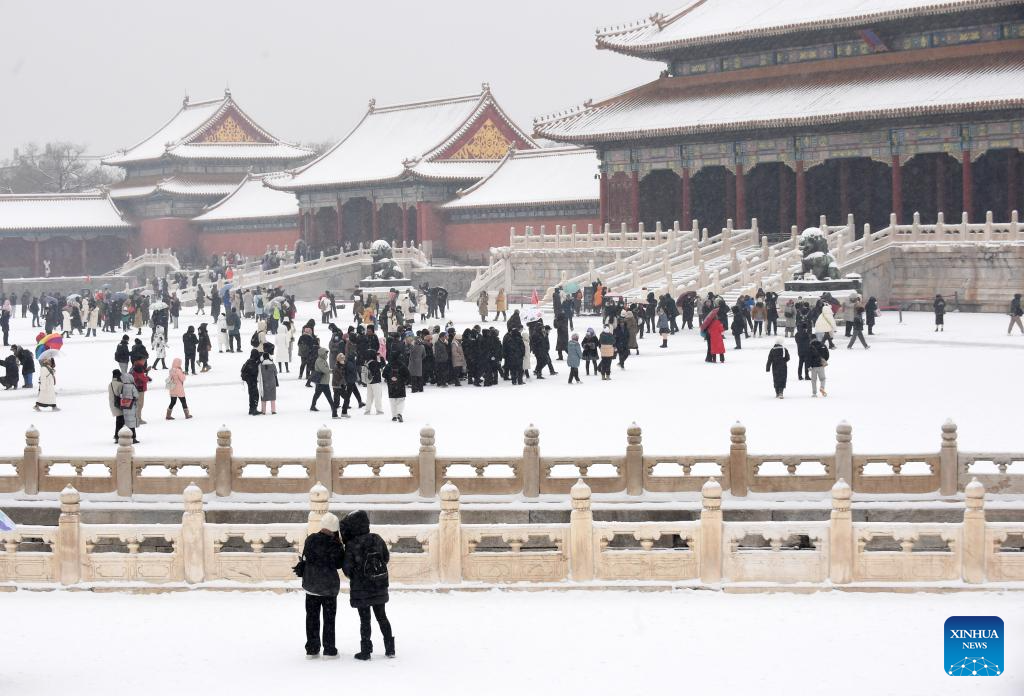
Visitors enjoy snow scenery at the Palace Museum in Beijing, capital of China, Dec. 14, 2023.
First created in the Yuan Dynasty (1271-1368), the Beijing Central Axis, or Zhongzhouxian, stretches 7.8 kilometers between the Yongding Gate in the south of the city and the Drum Tower and Bell Tower in the north. Most of the major old-city buildings of Beijing sit along this axis.
Gates, palaces, temples, squares and gardens of the old city are all linked up to the axis. As they witnessed the folk activities along the line from old days to new ones, they themselves are a joy to behold at all times. (Xinhua/Luo Xiaoguang)
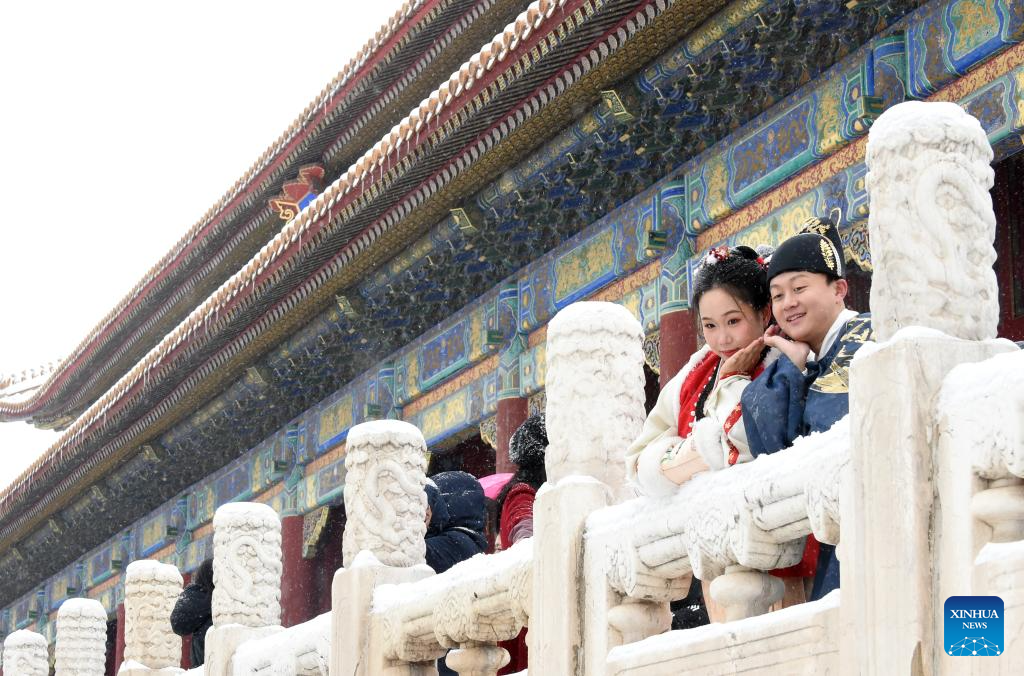
Visitors pose for photos in traditional Chinese costumes at the Palace Museum in Beijing, capital of China, Dec. 14, 2023.
First created in the Yuan Dynasty (1271-1368), the Beijing Central Axis, or Zhongzhouxian, stretches 7.8 kilometers between the Yongding Gate in the south of the city and the Drum Tower and Bell Tower in the north. Most of the major old-city buildings of Beijing sit along this axis.
Gates, palaces, temples, squares and gardens of the old city are all linked up to the axis. As they witnessed the folk activities along the line from old days to new ones, they themselves are a joy to behold at all times. (Xinhua/Luo Xiaoguang)
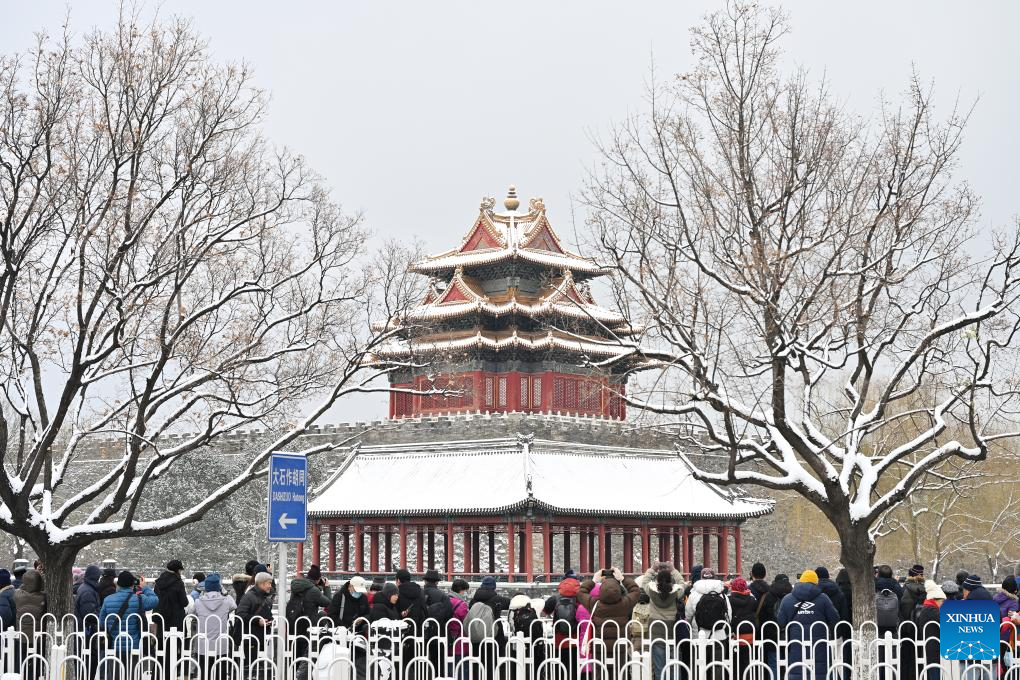
Visitors take photos in front of a turret of the Palace Museum in snowfall in Beijing, capital of China, Dec. 11, 2023.
First created in the Yuan Dynasty (1271-1368), the Beijing Central Axis, or Zhongzhouxian, stretches 7.8 kilometers between the Yongding Gate in the south of the city and the Drum Tower and Bell Tower in the north. Most of the major old-city buildings of Beijing sit along this axis.
Gates, palaces, temples, squares and gardens of the old city are all linked up to the axis. As they witnessed the folk activities along the line from old days to new ones, they themselves are a joy to behold at all times. (Xinhua/Li Xin)

This photo taken on Dec. 11, 2023 shows the Tian'anmen Square in snowfall in Beijing, capital of China.
First created in the Yuan Dynasty (1271-1368), the Beijing Central Axis, or Zhongzhouxian, stretches 7.8 kilometers between the Yongding Gate in the south of the city and the Drum Tower and Bell Tower in the north. Most of the major old-city buildings of Beijing sit along this axis.
Gates, palaces, temples, squares and gardens of the old city are all linked up to the axis. As they witnessed the folk activities along the line from old days to new ones, they themselves are a joy to behold at all times. (Xinhua/Ren Chao)
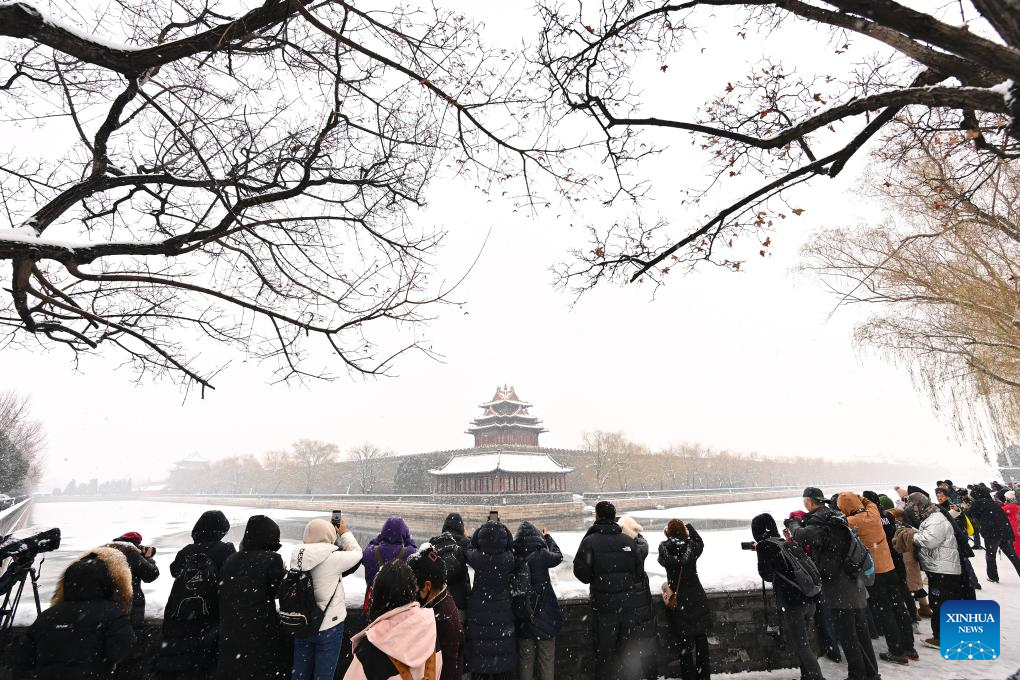
Visitors take photos in front of a turret of the Palace Museum in snowfall in Beijing, capital of China, Dec. 13, 2023.
First created in the Yuan Dynasty (1271-1368), the Beijing Central Axis, or Zhongzhouxian, stretches 7.8 kilometers between the Yongding Gate in the south of the city and the Drum Tower and Bell Tower in the north. Most of the major old-city buildings of Beijing sit along this axis.
Gates, palaces, temples, squares and gardens of the old city are all linked up to the axis. As they witnessed the folk activities along the line from old days to new ones, they themselves are a joy to behold at all times. (Xinhua/Li Xin)
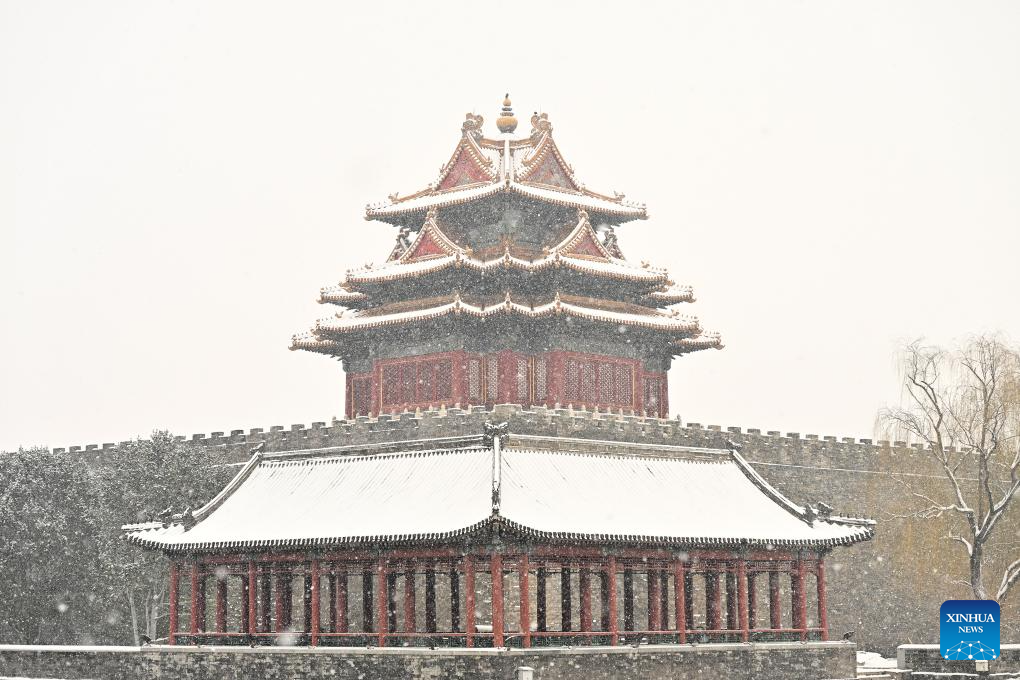
This photo taken on Dec. 13, 2023 shows a turret of the Palace Museum in snowfall in Beijing, capital of China.
First created in the Yuan Dynasty (1271-1368), the Beijing Central Axis, or Zhongzhouxian, stretches 7.8 kilometers between the Yongding Gate in the south of the city and the Drum Tower and Bell Tower in the north. Most of the major old-city buildings of Beijing sit along this axis.
Gates, palaces, temples, squares and gardens of the old city are all linked up to the axis. As they witnessed the folk activities along the line from old days to new ones, they themselves are a joy to behold at all times. (Xinhua/Li Xin)
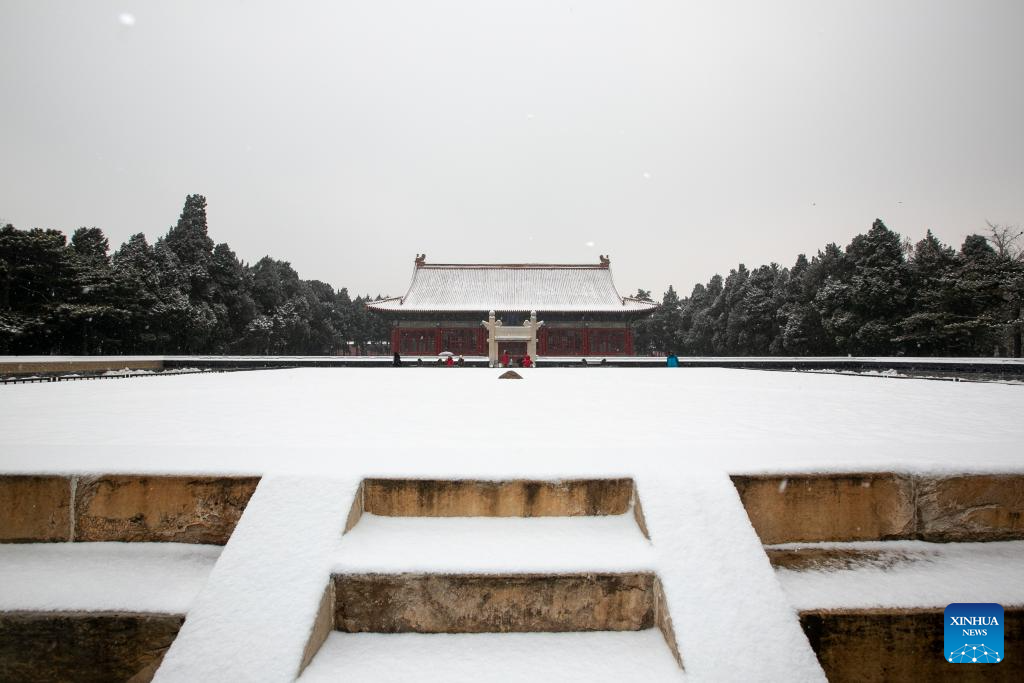
This photo taken on Dec. 13, 2023 shows the Altar of Land and Grain in snowfall in Beijing, capital of China.
First created in the Yuan Dynasty (1271-1368), the Beijing Central Axis, or Zhongzhouxian, stretches 7.8 kilometers between the Yongding Gate in the south of the city and the Drum Tower and Bell Tower in the north. Most of the major old-city buildings of Beijing sit along this axis.
Gates, palaces, temples, squares and gardens of the old city are all linked up to the axis. As they witnessed the folk activities along the line from old days to new ones, they themselves are a joy to behold at all times. (Xinhua/Li Jing)
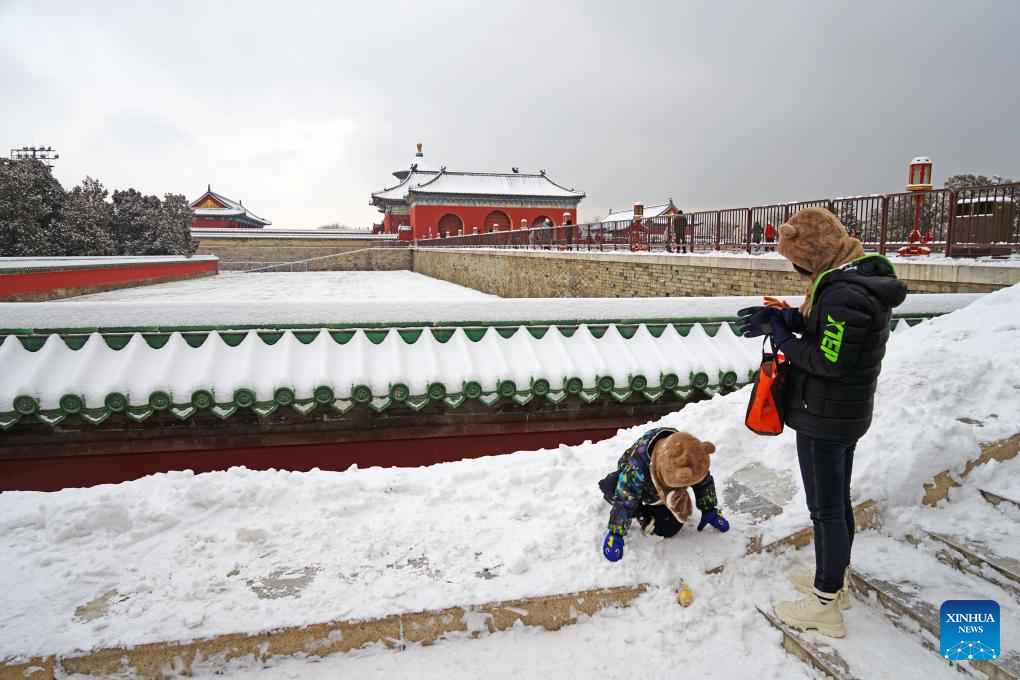
A mother and her child play with the snow at the Temple of Heaven in Beijing, capital of China, Dec. 11, 2023.
First created in the Yuan Dynasty (1271-1368), the Beijing Central Axis, or Zhongzhouxian, stretches 7.8 kilometers between the Yongding Gate in the south of the city and the Drum Tower and Bell Tower in the north. Most of the major old-city buildings of Beijing sit along this axis.
Gates, palaces, temples, squares and gardens of the old city are all linked up to the axis. As they witnessed the folk activities along the line from old days to new ones, they themselves are a joy to behold at all times. (Xinhua/Mu Wenchun)
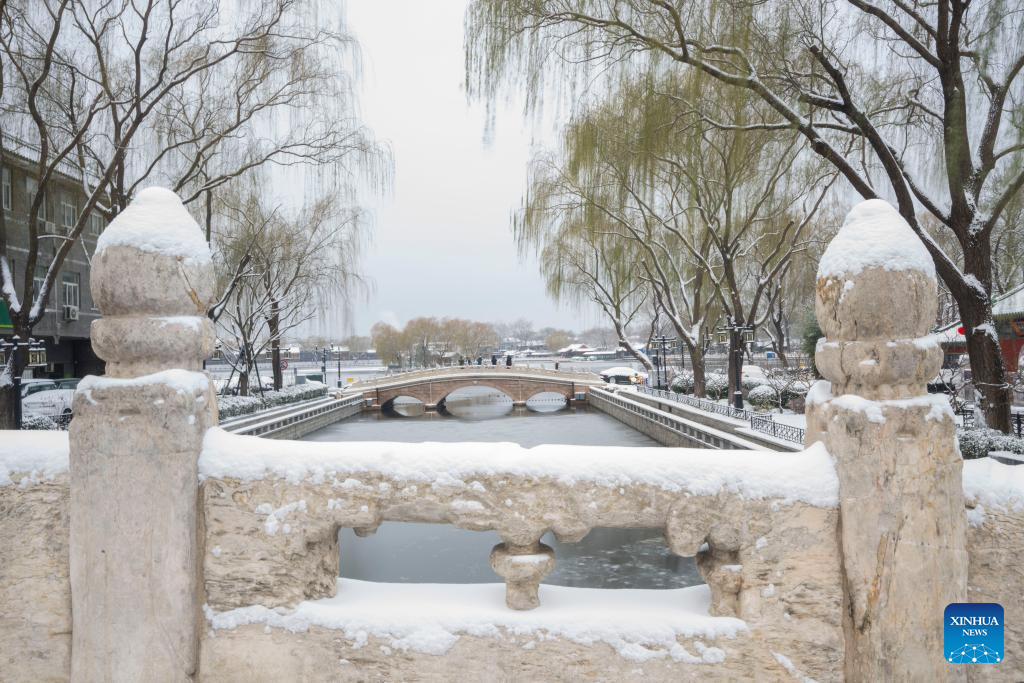
This photo taken on Dec. 11, 2023 shows the snow scenery of the Wanning Bridge in Beijing, capital of China.
First created in the Yuan Dynasty (1271-1368), the Beijing Central Axis, or Zhongzhouxian, stretches 7.8 kilometers between the Yongding Gate in the south of the city and the Drum Tower and Bell Tower in the north. Most of the major old-city buildings of Beijing sit along this axis.
Gates, palaces, temples, squares and gardens of the old city are all linked up to the axis. As they witnessed the folk activities along the line from old days to new ones, they themselves are a joy to behold at all times. (Xinhua/Cai Yang)
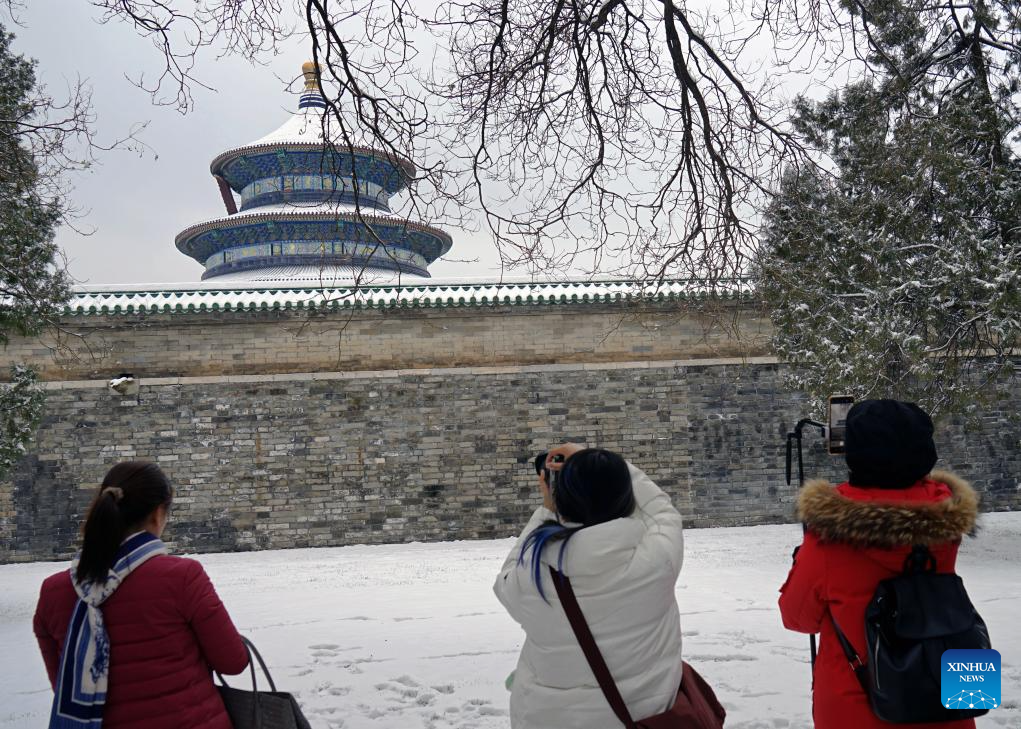
People take photos outside the Hall of Prayer for Good Harvest of the Temple of Heaven in Beijing, capital of China, Dec. 11, 2023.
First created in the Yuan Dynasty (1271-1368), the Beijing Central Axis, or Zhongzhouxian, stretches 7.8 kilometers between the Yongding Gate in the south of the city and the Drum Tower and Bell Tower in the north. Most of the major old-city buildings of Beijing sit along this axis.
Gates, palaces, temples, squares and gardens of the old city are all linked up to the axis. As they witnessed the folk activities along the line from old days to new ones, they themselves are a joy to behold at all times. (Xinhua/Mu Wenchun)
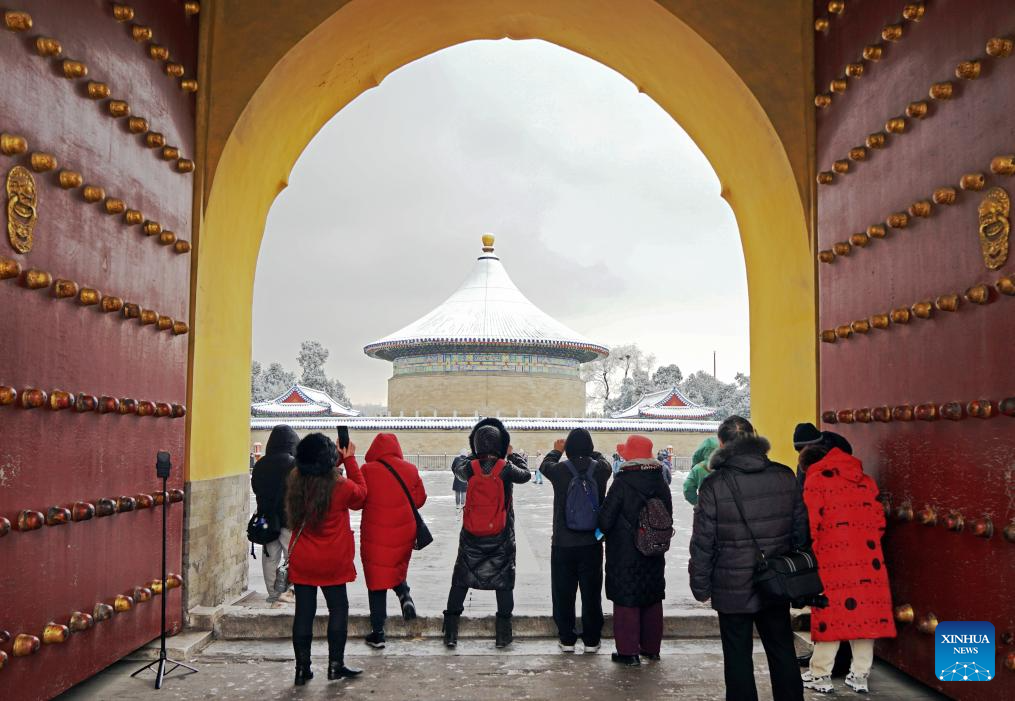
Visitors take photos at the Temple of Heaven in Beijing, capital of China, Dec. 11, 2023.
First created in the Yuan Dynasty (1271-1368), the Beijing Central Axis, or Zhongzhouxian, stretches 7.8 kilometers between the Yongding Gate in the south of the city and the Drum Tower and Bell Tower in the north. Most of the major old-city buildings of Beijing sit along this axis.
Gates, palaces, temples, squares and gardens of the old city are all linked up to the axis. As they witnessed the folk activities along the line from old days to new ones, they themselves are a joy to behold at all times. (Xinhua/Mu Wenchun)
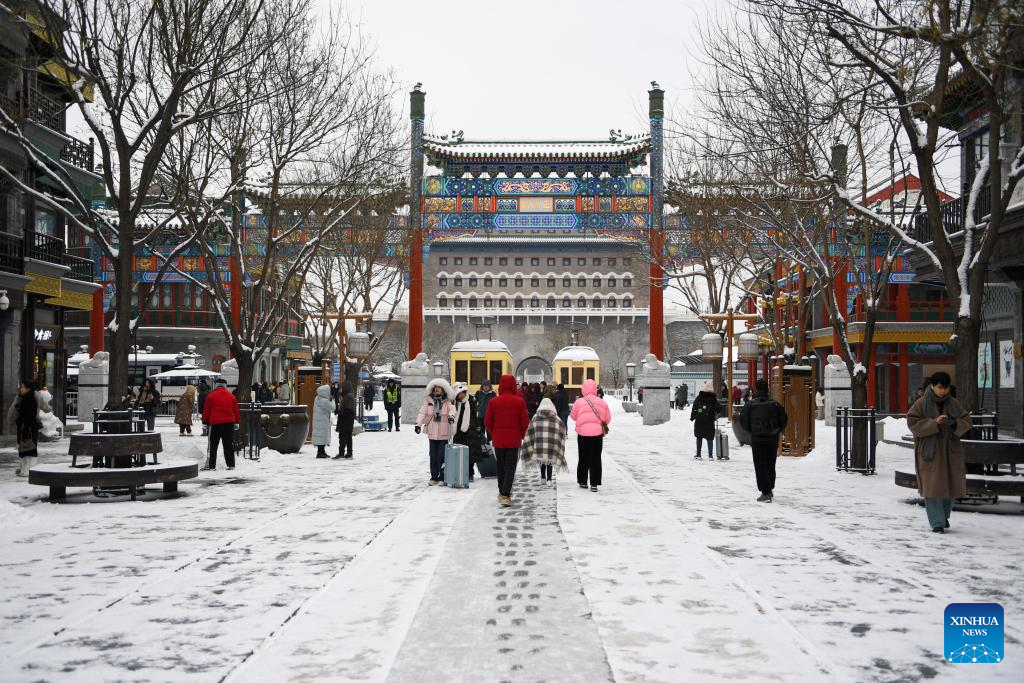
People visit the Qianmen Street in front of the Zhengyang Gate arrow tower in snowfall in Beijing, capital of China, Dec. 14, 2023.
First created in the Yuan Dynasty (1271-1368), the Beijing Central Axis, or Zhongzhouxian, stretches 7.8 kilometers between the Yongding Gate in the south of the city and the Drum Tower and Bell Tower in the north. Most of the major old-city buildings of Beijing sit along this axis.
Gates, palaces, temples, squares and gardens of the old city are all linked up to the axis. As they witnessed the folk activities along the line from old days to new ones, they themselves are a joy to behold at all times. (Xinhua/Ju Huanzong)
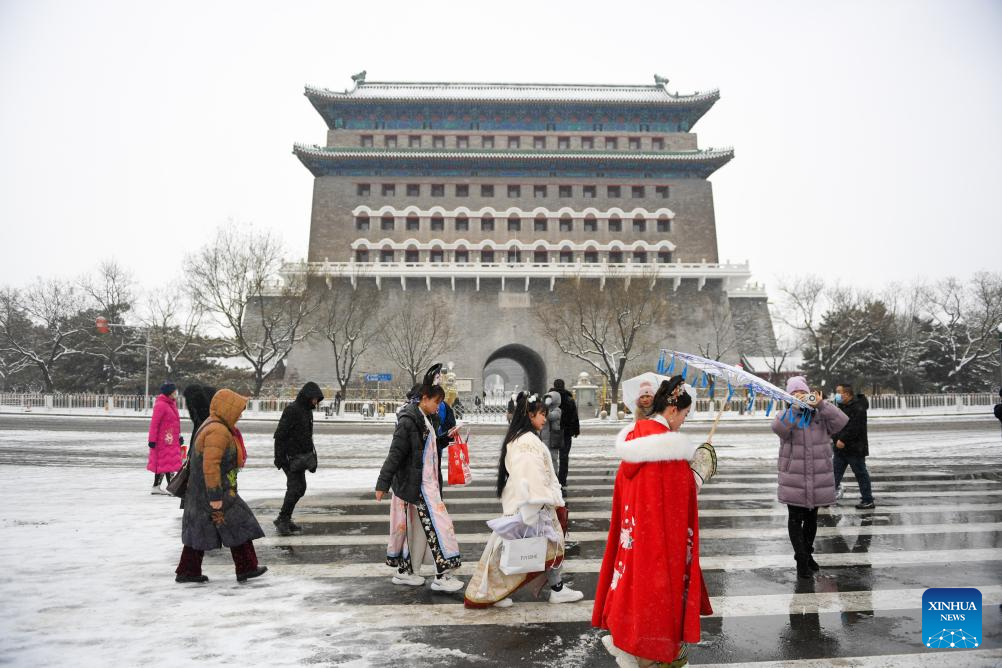
People walk in front of the Zhengyang Gate arrow tower after snowfall in Beijing, capital of China, Dec. 14, 2023.
First created in the Yuan Dynasty (1271-1368), the Beijing Central Axis, or Zhongzhouxian, stretches 7.8 kilometers between the Yongding Gate in the south of the city and the Drum Tower and Bell Tower in the north. Most of the major old-city buildings of Beijing sit along this axis.
Gates, palaces, temples, squares and gardens of the old city are all linked up to the axis. As they witnessed the folk activities along the line from old days to new ones, they themselves are a joy to behold at all times. (Xinhua/Ju Huanzong)

This photo taken on Dec. 14, 2023 shows the Zhengyang Gate in snowfall in Beijing, capital of China.
First created in the Yuan Dynasty (1271-1368), the Beijing Central Axis, or Zhongzhouxian, stretches 7.8 kilometers between the Yongding Gate in the south of the city and the Drum Tower and Bell Tower in the north. Most of the major old-city buildings of Beijing sit along this axis.
Gates, palaces, temples, squares and gardens of the old city are all linked up to the axis. As they witnessed the folk activities along the line from old days to new ones, they themselves are a joy to behold at all times. (Xinhua/Ju Huanzong)
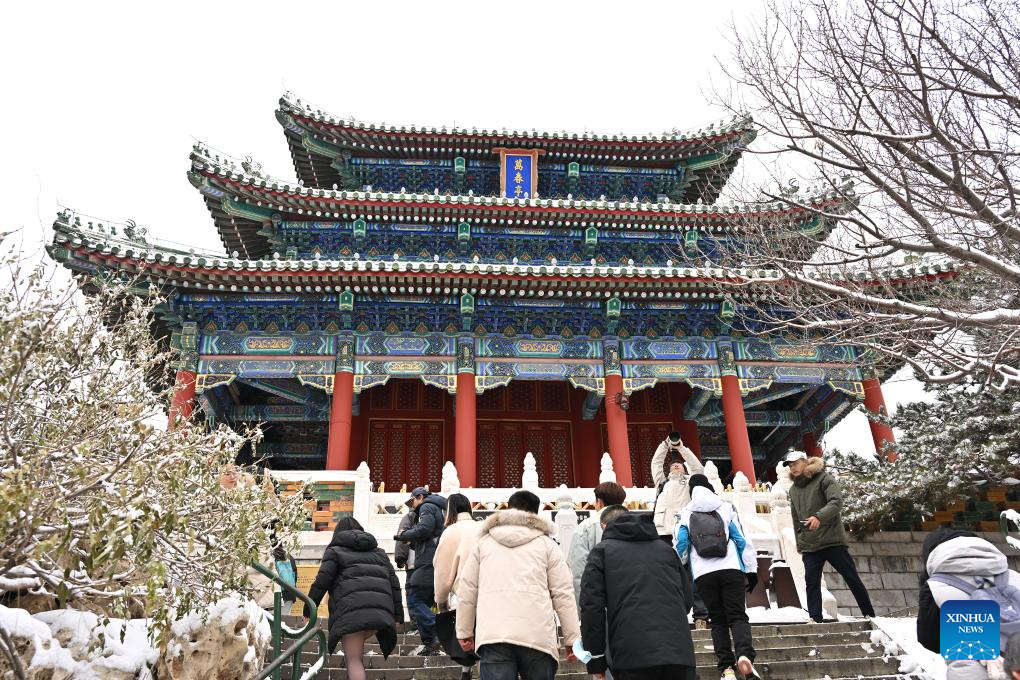
This photo taken on Dec. 11, 2023 shows people visiting the Wanchun pavilion on the mountain top of the Jingshan park in Beijing, capital of China.
First created in the Yuan Dynasty (1271-1368), the Beijing Central Axis, or Zhongzhouxian, stretches 7.8 kilometers between the Yongding Gate in the south of the city and the Drum Tower and Bell Tower in the north. Most of the major old-city buildings of Beijing sit along this axis.
Gates, palaces, temples, squares and gardens of the old city are all linked up to the axis. As they witnessed the folk activities along the line from old days to new ones, they themselves are a joy to behold at all times. (Xinhua/Li Xin)

Visitors take photos in front of a turret of the Palace Museum in snowfall in Beijing, capital of China, Dec. 11, 2023.
First created in the Yuan Dynasty (1271-1368), the Beijing Central Axis, or Zhongzhouxian, stretches 7.8 kilometers between the Yongding Gate in the south of the city and the Drum Tower and Bell Tower in the north. Most of the major old-city buildings of Beijing sit along this axis.
Gates, palaces, temples, squares and gardens of the old city are all linked up to the axis. As they witnessed the folk activities along the line from old days to new ones, they themselves are a joy to behold at all times. (Xinhua/Li Xin)
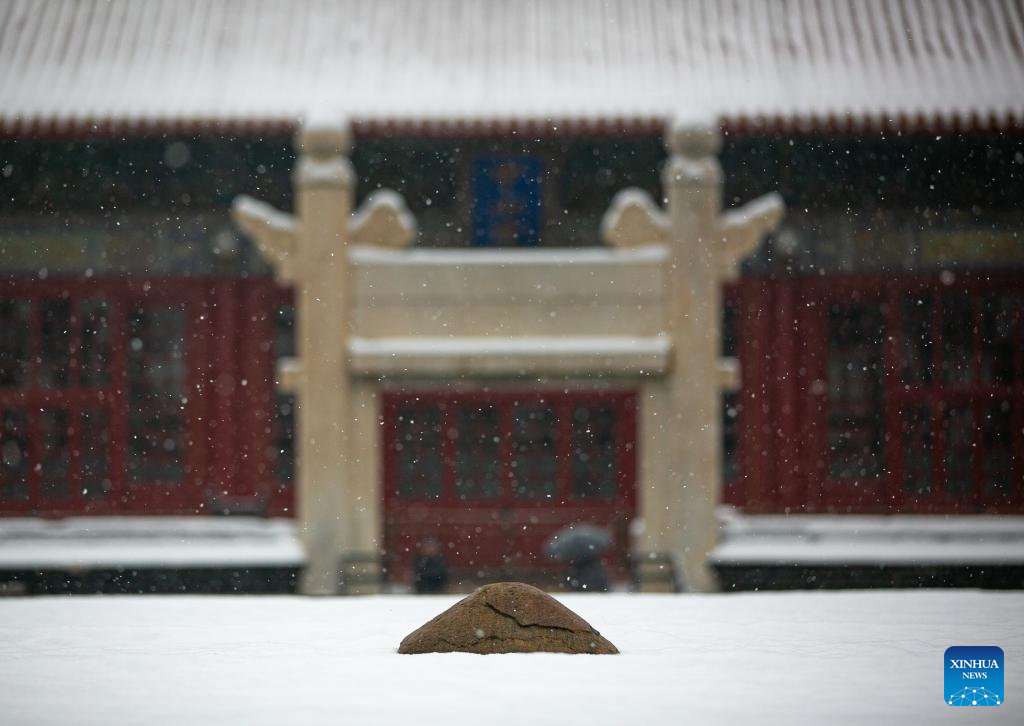
This photo taken on Dec. 13, 2023 shows the Altar of Land and Grain in snowfall in Beijing, capital of China.
First created in the Yuan Dynasty (1271-1368), the Beijing Central Axis, or Zhongzhouxian, stretches 7.8 kilometers between the Yongding Gate in the south of the city and the Drum Tower and Bell Tower in the north. Most of the major old-city buildings of Beijing sit along this axis.
Gates, palaces, temples, squares and gardens of the old city are all linked up to the axis. As they witnessed the folk activities along the line from old days to new ones, they themselves are a joy to behold at all times. (Xinhua/Li Jing)
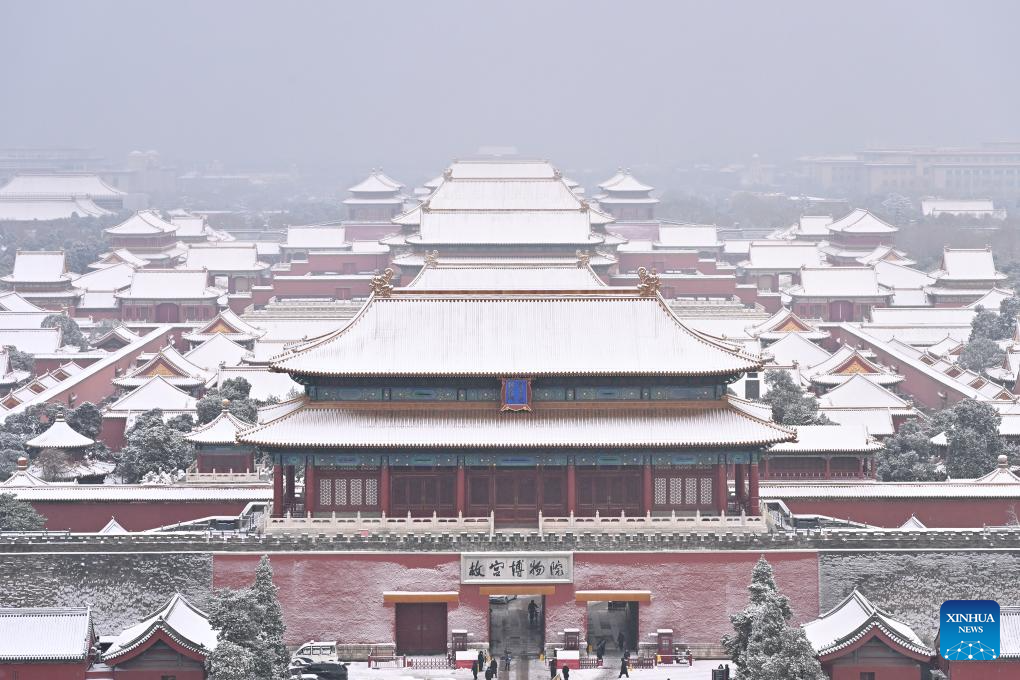
This photo taken on Dec. 11, 2023 shows the snow scenery of the Palace Museum seen from the Jingshan Mountain in Beijing, capital of China.
First created in the Yuan Dynasty (1271-1368), the Beijing Central Axis, or Zhongzhouxian, stretches 7.8 kilometers between the Yongding Gate in the south of the city and the Drum Tower and Bell Tower in the north. Most of the major old-city buildings of Beijing sit along this axis.
Gates, palaces, temples, squares and gardens of the old city are all linked up to the axis. As they witnessed the folk activities along the line from old days to new ones, they themselves are a joy to behold at all times. (Xinhua/Li Xin)
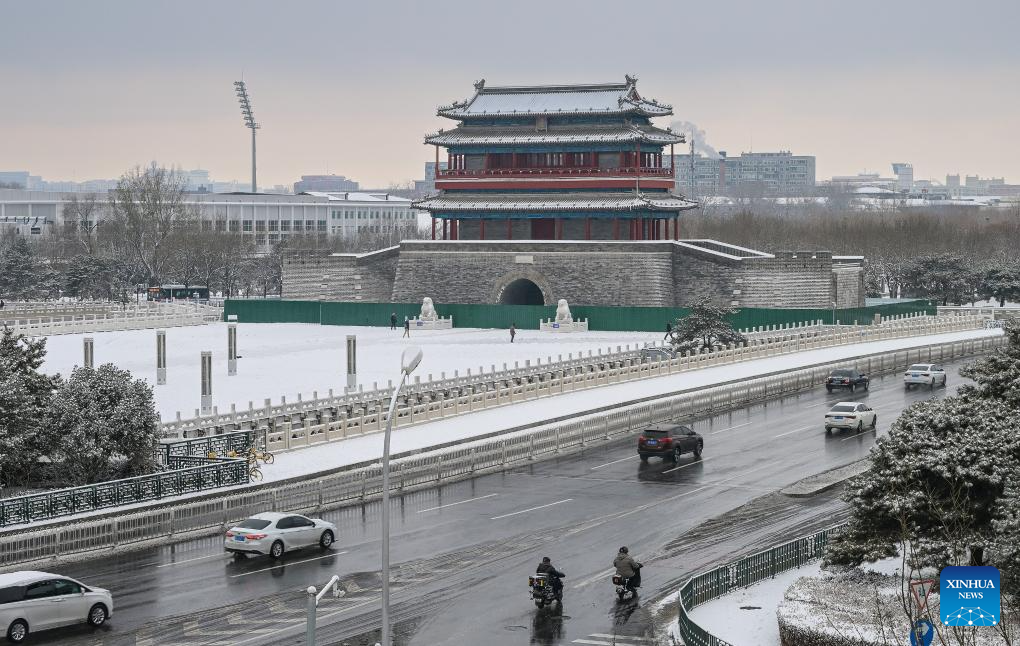
This photo taken on Dec. 11, 2023 shows the Yongding Gate after snowfall in Beijing, capital of China.
First created in the Yuan Dynasty (1271-1368), the Beijing Central Axis, or Zhongzhouxian, stretches 7.8 kilometers between the Yongding Gate in the south of the city and the Drum Tower and Bell Tower in the north. Most of the major old-city buildings of Beijing sit along this axis.
Gates, palaces, temples, squares and gardens of the old city are all linked up to the axis. As they witnessed the folk activities along the line from old days to new ones, they themselves are a joy to behold at all times. (Xinhua/Li He)
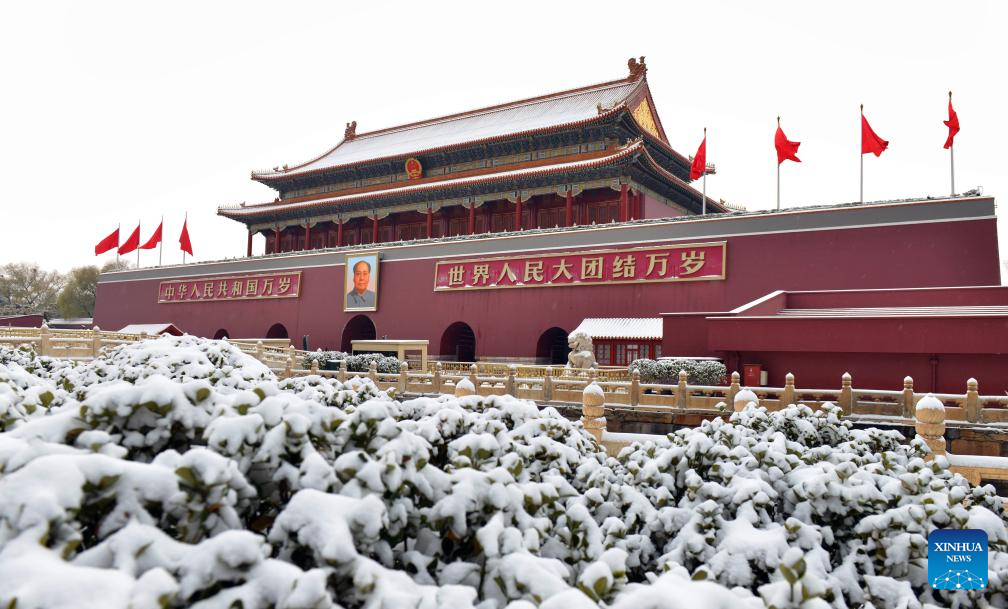
This photo taken on Dec. 13, 2023 shows the Tian'anmen Rostrum in snowfall in Beijing, capital of China.
First created in the Yuan Dynasty (1271-1368), the Beijing Central Axis, or Zhongzhouxian, stretches 7.8 kilometers between the Yongding Gate in the south of the city and the Drum Tower and Bell Tower in the north. Most of the major old-city buildings of Beijing sit along this axis.
Gates, palaces, temples, squares and gardens of the old city are all linked up to the axis. As they witnessed the folk activities along the line from old days to new ones, they themselves are a joy to behold at all times. (Xinhua/Ren Chao)
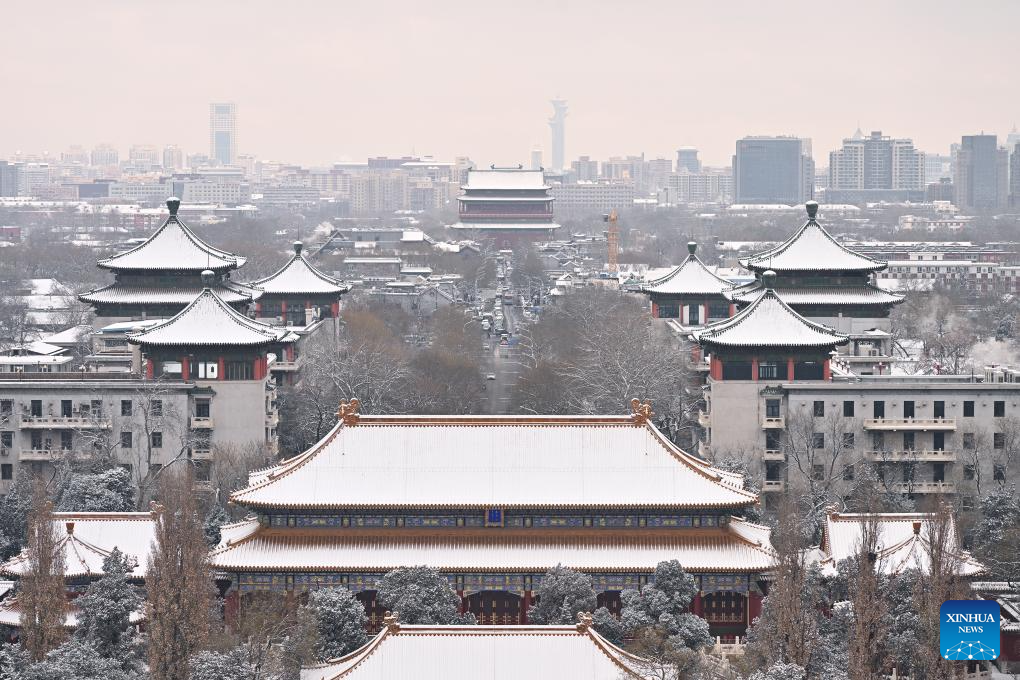
This photo taken on Dec. 11, 2023 shows the snow scenery of the Drum Tower seen from the Jingshan Mountain in Beijing, capital of China.
First created in the Yuan Dynasty (1271-1368), the Beijing Central Axis, or Zhongzhouxian, stretches 7.8 kilometers between the Yongding Gate in the south of the city and the Drum Tower and Bell Tower in the north. Most of the major old-city buildings of Beijing sit along this axis.
Gates, palaces, temples, squares and gardens of the old city are all linked up to the axis. As they witnessed the folk activities along the line from old days to new ones, they themselves are a joy to behold at all times. (Xinhua/Li Xin)
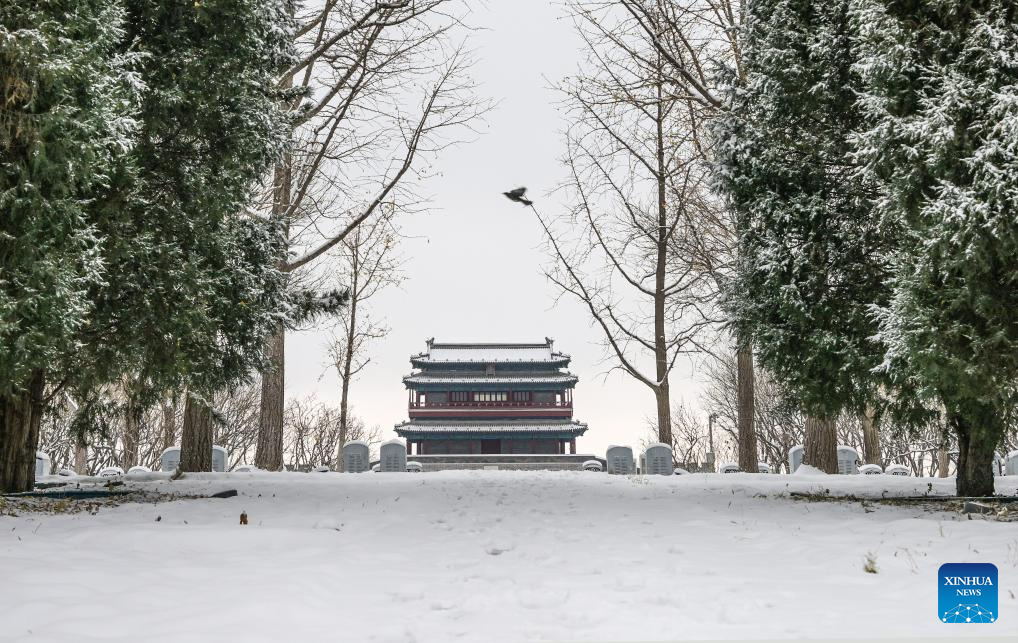
This photo taken on Dec. 11, 2023 shows the Yongding Gate after snowfall in Beijing, capital of China.
First created in the Yuan Dynasty (1271-1368), the Beijing Central Axis, or Zhongzhouxian, stretches 7.8 kilometers between the Yongding Gate in the south of the city and the Drum Tower and Bell Tower in the north. Most of the major old-city buildings of Beijing sit along this axis.
Gates, palaces, temples, squares and gardens of the old city are all linked up to the axis. As they witnessed the folk activities along the line from old days to new ones, they themselves are a joy to behold at all times. (Xinhua/Li He)
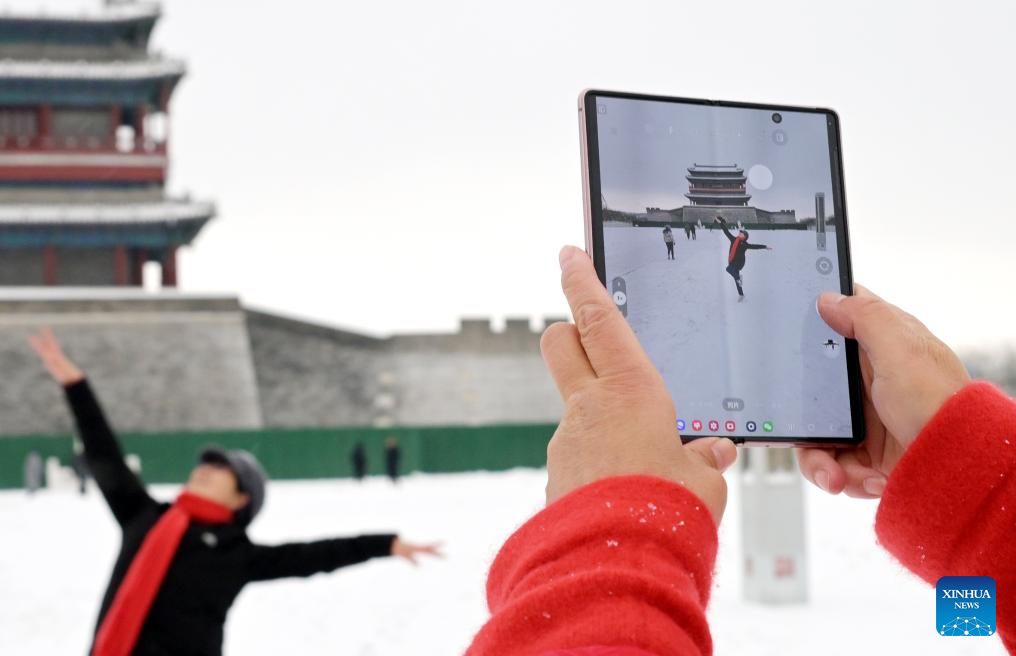
A visitor poses for photos at the Yongding Gate in Beijing, capital of China, Dec. 11, 2023.
First created in the Yuan Dynasty (1271-1368), the Beijing Central Axis, or Zhongzhouxian, stretches 7.8 kilometers between the Yongding Gate in the south of the city and the Drum Tower and Bell Tower in the north. Most of the major old-city buildings of Beijing sit along this axis.
Gates, palaces, temples, squares and gardens of the old city are all linked up to the axis. As they witnessed the folk activities along the line from old days to new ones, they themselves are a joy to behold at all times. (Xinhua/Li He)
点击右上角![]() 微信好友
微信好友
 朋友圈
朋友圈

请使用浏览器分享功能进行分享
